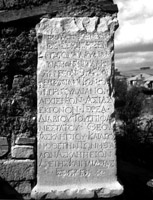 MAMA XI 101 (Akmoneia)
MAMA XI 101 (Akmoneia) 
Honorific base for C. Claudius Terentullianus
- Type of monument:
- Honorific base.
- Location:
- Ahat (Akmoneia): in the wall of a house near the school.
- Description:
- Off-white marble base with mouldings above and below. Upper moulding broken, otherwise complete.
- Dimensions:
- Ht. 1.04; W. 0.44-0.47 (shaft), 0.56 (lower moulding); Th. 0.43-0.46 (shaft), 0.51 (lower moulding); letters 0.027-0.045.
- Record:
- MB notebook copy; photograph (1955/99).
- Publication:
- None.
- Date:
- c. AD 150-200 (letter-forms; prosopography)
[ἡ] βουλὴ · κα̣ὶ ὁ δῆ-
[μ]ος · ἐτείμησεν
[. ]ι̣ · Γάϊον Κλαύδιον
[Ἐ]γνάτιον Βιγέλλιον
5Οὐαλέριον Οὔλπιον
Ἀντώνιον Πωλ̣ί̣ων̣[α]
Τερεντυλλιανὸν
ἀρχιερέων · Ἀσίας
ἔκγονον · ἱερέα ·
10διὰ βίου τοῦ ἐπιφα-
νεστάτου · θεοῦ
Ἀσκληπιοῦ · καὶ ἀγω-
νοθέτην τῶν μεγά-
λων Ἀσκληπείων
15ἀρετῆς καὶ παιδείας
hed. ἕνεκεν hed.
The council and the people honoured [.] Gaius Claudius Egnatius Vigellius Valerius Ulpius Antonius Pollio Terentullianus, descendant of high-priests of Asia, priest for life of the most manifest god Asklepios, and agonothete of the Great Asklepeia festival, for the sake of his virtue and culture.




This monument is an honorific base voted by the boule and demos of Akmoneia for a certain [.] Gaius Claudius Egnatius Vigellius Valerius Ulpius Antonius Pollio Terentullianus. The honorand appears to have possessed two praenomina (Salomies 1987: 414-8), the first of which stood in abbreviated form at the beginning of line 3. An upright stroke with a serif at its base is clearly visible before the interpunct; it is not clear whether this stroke is an iota, or the right-hand bar of a mu or pi. The stone is broken at left, and there is space for a single letter or part of a letter before the upright stroke. The readings [Τ]ι̣ · or Μ̣ · or Π̣ · all seem possible. For the gentilician Egnatius (line 4), see the commentary to MAMA XI 66 (1956/34: Sebaste).
The honorand’s name also includes the relatively rare gentilician Vigellius (Βιγέλλιον, line 4: the reading is certain). A family of Vigellii is known to have resided in eastern Lydia in the late Republican and early imperial period: TAM V 3, 1692 (Philadelpheia, first century BC: Gaius Vigellius); AE 2005, 1452 (Salihli, near Philadelpheia, 17 BC: M. Vigellius Rufus); SEG 48, 1428 (NE Lydia, either 23/2 BC or AD 33/34: Tertia Vigellia). The family were presumably Roman negotiatores in origin, but they settled in the region permanently: a certain M. Vigellius Capito is found making a dedication at the sanctuary of Apollo Lairbenos in the late second or early third century AD (SEG 50, 1257). It seems likely that the honorand is a descendant of a member of this family.
The most prominent bearer of the gentilician Vigellius in the high imperial period is P. Vigellius Saturninus (Stiglitz, RE VIII A 2569-70; Alföldy 1977: 365-7), legate of Pamphylia-Lycia c. AD 159-162 (Şahin 1992: 78-81; I.Side 58; I.Perge 141-3; I.Perge 158), suffect consul c. AD 165, proconsul of Africa 180/181 (Thomasson 1996: 71). It has been argued that the name of an earlier proconsul of Africa (c. AD 150), M. Atilius Metilius Bradua Caucidius Tertullus [- -]licus [- -]llius Pollio Gavidius Latiaris Atrius Bassus (IRT 517), is to be restored [Vige]llius Pollio (Di Vita-Évrard 1981: 199-202; Thomasson 1996: 95-6; contra, Settipani 2000: 474-6). If this restoration is correct, it becomes a little more likely that our honorand (who also carried the cognomen Pollio: line 6) is a relative of these two African proconsuls.
The honorand is described as ‘descendant of high-priests of Asia’ (lines 8-9). On the basis of the patronymic adjective Τερεντυλλιανός (line 7), we can identify four of these ancestors: (1) M. Claudius Valerianus and his wife (2) Claudia Terentulla, high-priest and high-priestess of Asia during the reign of Domitian (RPC II 1386-8 [Eumeneia], as corrected by Weiss 2000a: 236-9; Campanile 1994: 44, no. 20); (3) their descendant Claudius Valerianus Terentullianus, high-priest of Asia c. AD 130-138 (SEG 28, 1115; SEG 50, 1245 [Balçıkhisar: Eumeneia]; MAMA IV 336 [Işıklı: Eumeneia]; Drew-Bear 1978: 67-70; Campanile 1994: 45, no. 20a; Weiss 2000b: 623-4 [date]); (4) M. Flavius Valerianus Terentullianus, high-priest of Asia in the mid-second century AD (SEG 52, 1342). The family appears to have been domiciled at Eumeneia. Connections between Eumeneia and Akmoneia were close: a funerary inscription from Eumeneia of the second century AD was set up by an individual with joint Eumeneian and Akmoneian citizenship (Ramsay, Phrygia II 389, no. 238 [Işıklı]; Strubbe 1997: no. 289), and a coinage celebrating homonoia between the two cities was minted in the reign of Maximus (AD 236-238: Franke and Nollé 1997: nos. 35-8). See further MAMA XI 123 (1955/93).
The honorand is further stated to be priest for life of the ‘most manifest’ (ἐπιφανέστατος) god Asklepios and agonothete of the megala Asklepeia at Akmoneia (lines 9-14). That Asklepios was the principal deity of Akmoneia may be inferred from the fact that he appears as the city’s representative on the homonoia-coinages of Akmoneia (with Aizanoi and Eumeneia, Franke and Nollé 1997: nos. 34-8; Riethmüller 2005: II 388); his cult titles at Akmoneia included Soter (IGR IV 661.23 [SEG 50, 1236]: AD 95) and Sebastos (AE 2006, 1426, lines 39-40: διὰ βίου [ἱ]ερεὺς Σεβαστοῦ Ἀσκληπίου). Ἀσκλήπεια festivals are attested at numerous cities of Asia Minor in the imperial period (Robert 1969: 291-4; Riethmüller 2005: I 60-1); the title μεγάλα may suggest that the Akmoneian Asklepeia were penteteric (cf. I.Prusias ad Hypium 6, with commentary).
In lines 15-16, we are told that the honorand is distinguished particularly for his ‘virtue’ (ἀρετή) and his ‘(literary) culture’ (παιδεία). For the latter quality, see Robert 1938: 25 n.5, and cf. e.g. TAM V 2, 976 (Thyateira): ἄνδρα ἤθους ἕνεκα καὶ παιδείας καὶ ἀρετῆς τε πάσης ἐν τοῖς πρώτοις τῆς Ἀσίας καταριθμούμενον, ‘a man counted among the foremost in Asia for the sake of his character, culture, and all his virtue’.